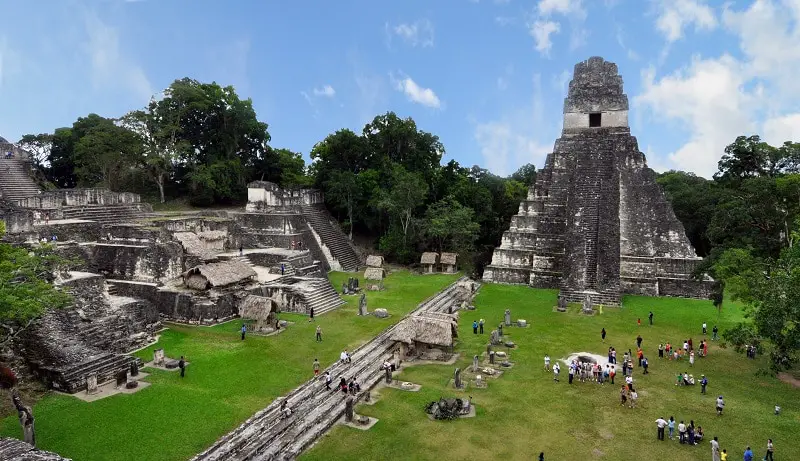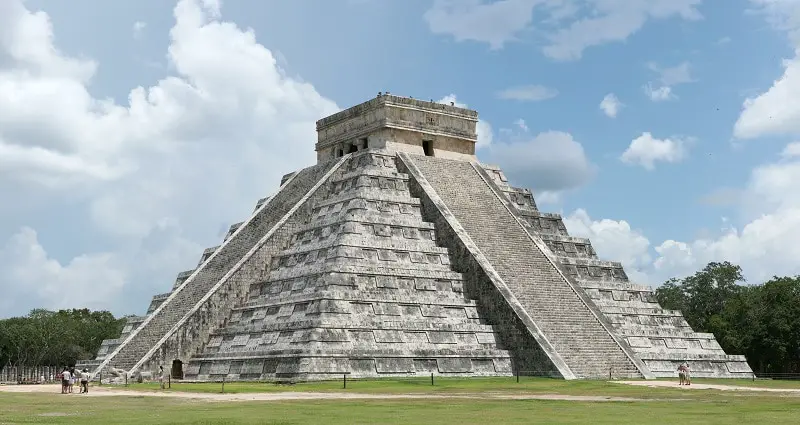The ancient civilizations of Mexico were some of the most formidable cultures to inhabit Central America. The ruins of the cities and sacred sites that these Mesoamerican peoples once inhabited draw crowds and visitors from all over the world. We are in turn awestruck and fascinated by these sacred precincts, particularly the famous Mayan pyramids. The Maya lived in territories in southeast Mexico between 2000 BC and 1697 AD, including the sites of modern day Guatemala, Belize, Honduras and El Salvador. The famous stone temples and sculptures, situated on the Yucatán Peninsula, have endured for centuries and stand as testaments to the sophistication of Mayan culture.
The nearest airport to Yucatan is Cancun, which serves flights from major airports throughout Europe and the rest of the world. Flights can vary in price, depending on season. High Season, which lasts from December to April, is usually the most expensive time to travel, but the Low Seasons — from May to June and September to November — see flight and accommodation prices drop, and the crowds around the pyramids start to disperse. If you don’t mind the cooler weather, this is the best time to travel. Average round-trip prices for this season are listed below:
- London to Cancun – £350 to £500 app.
- Newark to Cancun – $220 to $300 app.
- JFK to Cancun – $250 to $400 app.
- Frankfurt to Cancun – €300 to €500 app.
Expedia, Skyscanner and the usual flight comparison websites are all good places to check for affordable deals, as are the websites of local airlines such as Thomson Airways in the UK.
Accommodation in the Yucatan is surprisingly affordable compared to other Mexican beachside destinations, and there’s a wide variety to suit all budgets. You can find rooms in hostels starting at $15 per night, and many offer camping options for a significantly lower rate, if you’d prefer to sleep under the stars. Airbnb is a great way to find affordable accommodation; prices start at $10 per night, and you’ll get to stay with a local and find out more about the culture and country. Hotels range in price and quality from $20 per night for a bnb-style room to in excess of $250 per night for a luxurious, beachside resort.
The main architectural sites across the peninsula can all be reached by road, so driving is the best way to get around, and you can take the time to plan out day trips or overnight stays. It’s also possible to arrange transport to the major sites through local tour operators; TripAdvisor has numerous tour operators listed.
Chichén Itzá is one of the most famous of all the remnants of the Mayan civilization. This UNESCO World Heritage site is now listed as one of the new 7 Wonders of the World. It was built during the late Classic and early Post-Classic periods, circa 800 to 1000 AD, and it features numerous architecture styles. The pyramid complexes span over three miles, and in its centre is El Castillo, a stunning 100-foot-tall pyramid with carved serpent heads at its base. Chichén Itzá draws the biggest crowds — around 1.5 million tourists experience its wonder each year — so it pays to take your time visiting and exploring the site. Located over 100 miles from Cancun and a 3 to 4-hour drive, it’s best to schedule an overnight stay in the area to get the most out of your visit. Local hotels near the site also offer early entrance for their guests, which is definitely something to take advantage of because the biggest crowds tend to arrive at midday.
The Puuc Ruins (Ruta Puuc) are typically overlooked by travelers who are drawn to the grandiosity of the major cities like Chichén and Coba. However, this smaller site is a forgotten gem and offers a true opportunity to connect with the spirit of the Mayan people. Consisting of five archeological sites situated on the southern stretch of Merida, exploring it all takes time, but it’s well worth it. There’s plenty to see architecturally, and there are also small jungles to explore and some stunning scenery. Start the trip with Labná, a rolling scrubland whose buildings are decorated with ornate facades. Then head to the 90-room El Palacio in Xlapak, followed by Kabah, with its exotic wildlife (like Mot-Mot birds and iguanas). Then head to Sabal and see the beautiful causeway with the temple pyramid El Mirador. Finally, you’ll reach Uxmal. Another UNESCO World Heritage site, Uxmal was an important capital in the Classic Period and is home to the 115-foot-tall Pyramid of the Magician.
Alternatively, if you prefer to fly into Mexico City, you will find there are a great choice of Mayan ruins that are reachable from the capital on a day trip. Take Teotihuacan for instance, which is less than an hour’s drive from Mexico City. This is an enchanting site, dominated by the Pyramids of the Sun and Moon, as well as the central Avenue of the Dead. It’s possible to discover Mayan ruins without even venturing outside of Mexico City too, with Templo Mayor home to ruins of the city’s former Aztec stronghold. There’s so much to see and do in Mexico City too, with the magnificent Chapultepec park to explore and the National Museum of Anthropology perfect for wiling away the hours. When the sun sets, why not experience some Mexican-style wrestling or watch some authentic folkloric ballet?
Other major Mayan sites to visit in Mexico are the cliff-side Tulum, Coba and Palenque, but there are hundreds of other sites further afield in El Salvador, Guatemala, Honduras and Belize. With some careful scheduling and travelling during the right season, it’s possible to visit many of these incredible places in a single trip.



